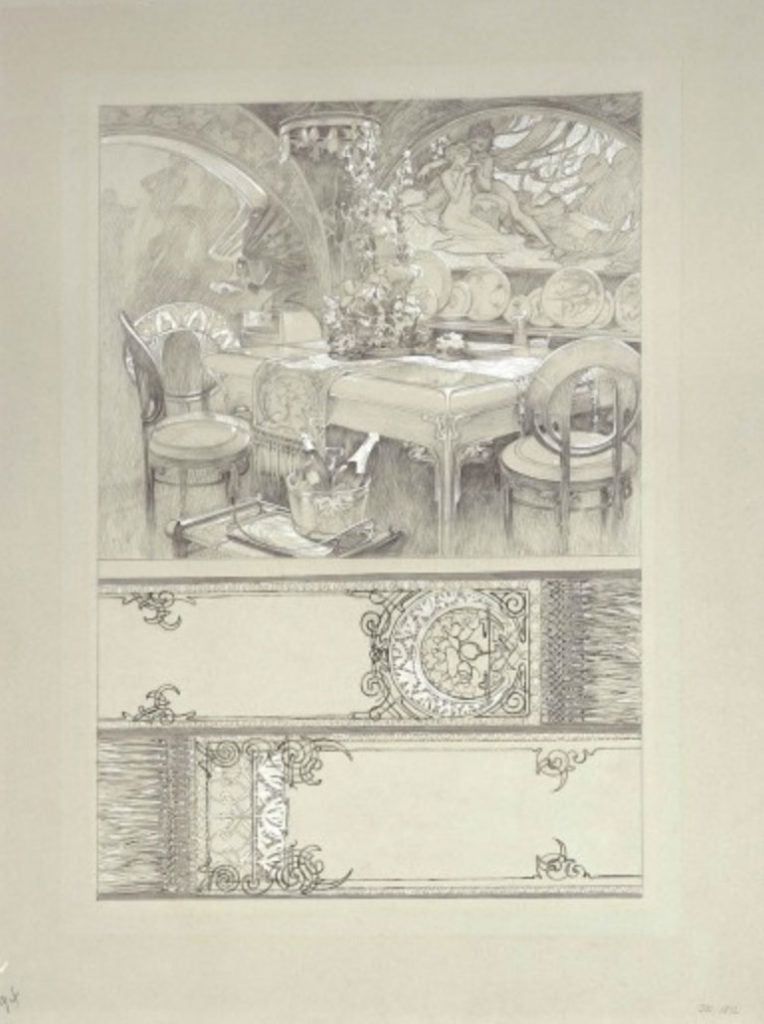Alphonse Mucha: The Master of Art Nouveau
There are few names as synonymous with the Art Nouveau era as Alphonse Mucha. Born of Bohemian spirit near the midpoint of the 19th century, Mucha would go on to revolutionize artistic production by fully embracing the age of Art Nouveau design through the myriad projects he undertook. He dabbled in interior design; he collaborated with colleagues to conjure contemporary jewelry; and he developed an approach to the graphic arts that secured his status as one of the most celebrated artists of his day. What unites his diverse range of production is his plethora of drawings. From studies for future paintings to detailed renderings of interior and object designs, Mucha's drawings showcase his remarkably talents as both draughtsman and artist.

Study for Medea, c. 1896 (image courtesy of author)
A native of Ivančice, Moravia (part of the modern-day Czech Republic), Mucha rose to prominence during a period marked by political and social changes in Europe. In many ways he channeled that sense of revolution into his art, a spirit that would fully manifest itself upon his arrival in Paris in 1887. The City of Lights was, at the time, completed enveloped in fin-de-siècle fervor, an energy that the young artist absorbed readily. He fed off of the enthusiasm for artistic innovation alongside the rich colors and modern forms of the late 19th-cenutry world, as arts were embracing the "new art" of Art Nouveau, one that blended ideas of art and design and emphasized the importance of the creative process.

Gismonda, 1894 Lithograph – 216 by 74.2 cm
Mucha was catapulted into artistic stardom following the release of his promotional poster design for famed French actress Sarah Bernhardt's lead role in Gismonda in 1894. The sheer success of that novel poster transformed Mucha into an artistic icon seemingly over night. He gained the admiration of Bernhardt herself – she subsequently signed a six-year contract with Mucha for her future posters, including that for Medea in 1898 – and soon his work became known as the epitome of the Art Nouveau aesthetic. Part of Mucha's appeal, though, was his ability to adapt his approach for such a wide array of implementations. From jewelry designs with his close friend Georges Fouquet to the entire interior design of Fouquet's flagship boutique on Paris' rue Royale, Mucha was an incredibly versatile figure whose style lent itself to a remarkable range of market in turn-of-the-century Europe.

Pencil and Wash on Paper – 52 by 39 cm (image courtesy of the Mucha Foundation)
While Mucha's acclaim spread internationally during the early 20th century, his later shift in focus toward more patriotic themes and his clash with the rising powers in Germany on the eve of World War II brought a subdued close to an otherwise brilliant career. To make matters worse, Mucha's art was mired in obscurity for decades following his demise in 1940. The 1960s and 1970s witnessed the first renewed interest in the artist through international publications and exhibitions, and in the early 1990s Mucha's descendants established the Mucha Foundation, which has grown over the past several decades to become the chief champion of Mucha's artistic genius. Thus, Mucha's acclaim is back on the rise, with new fans of his style constantly emerging.

Interior of Boutique Fouquet, Design for the Fireplace with statuettes, mirror, and the ornamental details of the wall, c. 1900 (image courtesy of the Mucha Foundation)
Are you a fan of Mucha's body of work? A superb retrospective of Mucha's career is currently on view at Rome's Complesso Vittoriano until 11 September 2016. Have you had a chance to visit it? Tell us about it here!
Thank you Adam. We have corrected the article.
You have a mistake in your article, Mucha wasn’t born in Bohemia, but in Moravia